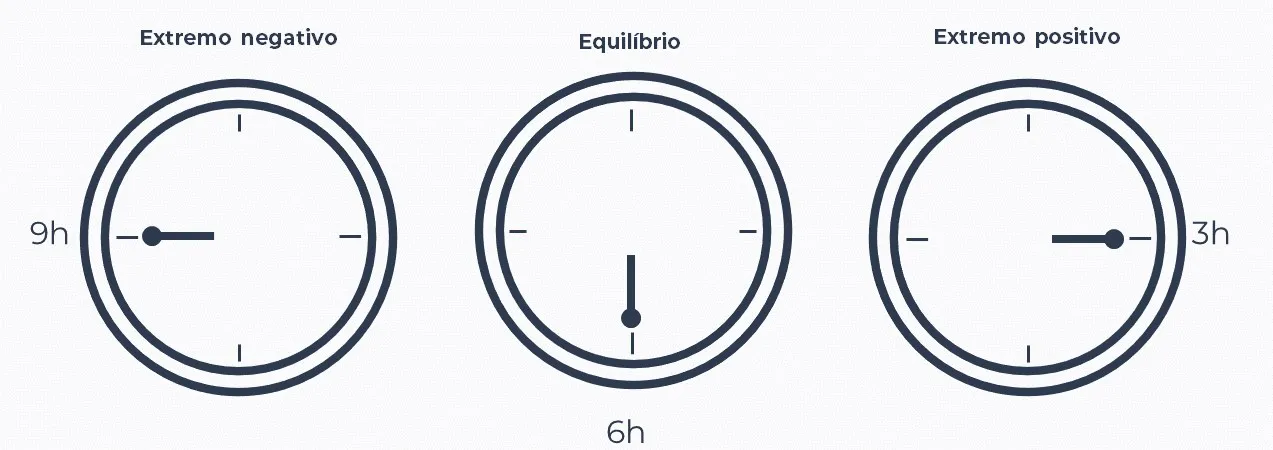The Market Pendulum
Dear investors,
In a 1991 memo written by Howard Marks, the renowned fundamentalist investor at the helm of Oaktree Capital Management, the movement of a pendulum is used as an analogy to describe the dynamics of market fluctuations. This idea of pendulum movement would be revisited several times by him (in other memos and in the books *The Most Important Thing* and *Mastering the Market Cycle*) and highlighted as one of the most fundamental concepts for understanding market behavior.
At the negative extreme, when the general sentiment is pessimistic and prices hit all-time lows, it's as if the pendulum were at the 9 o'clock position on a clock. At the opposite extreme, when the mood is one of widespread optimism and it seems nothing can go wrong, it's as if the pendulum were at the 3 o'clock position on the clock. The lowest point, at 6 o'clock, is where price levels should remain if markets were always rational and balanced. However, like the pendulum, the market spends less time at 6 o'clock than in sideways zones, with prices above or below what more balanced assessments indicate.
It seems counterintuitive to say that a market made up of intelligent and qualified investors spends most of its time with distorted notions about the real value of assets. However, rationality in markets is like the force of gravity acting on a pendulum. It always acts to bring it to the equilibrium point at 6:00 a.m. However, under the influence of an external force, this static equilibrium becomes dynamic: the pendulum oscillates around its equilibrium point, but never stops there. In the market, the external force that disturbs the static equilibrium and creates this pendulum dynamic is the nature of human psychology.

Application of the pendulum analogy
Imperfect as analogies often are, this one carries some important differences. The first is that the market's pendulum movement is not as regular and calculable as that of a physical pendulum. It's impossible to know how far the market will go or when it will reverse its movement. The second is that the market doesn't move in the same direction until it reaches its extreme points. There are a series of short-term reversals, with no consistent method for differentiating brief reversals from those that will prove to be inflection points in long-term trends. A more accurate analogy would be that of a pendulum made from a Styrofoam ball and exposed to winds blowing sometimes in one direction, sometimes in another, without following any predictable pattern.
Although this random component frustrates investors' eternal desire to predict future market prices, there are two practical conclusions we can draw from this analogy. The first is the awareness that, sooner or later, the market will reverse its direction and pass through its equilibrium point again. The second is that, by knowing the symptoms that become visible at the extremes of the market's pendulum movement, it is possible to estimate, with some confidence, whether the market is to the left or right of 6:00. Even though this information is imprecise, as it is impossible to know whether the pendulum is at 3:00 or 4:00, it is useful for indicating the direction in which the market is most likely to move in the long term. If it is towards 9:00, the greatest chance is that it will rise again, and if it is closer to 3:00, it is more likely to fall again.
Since the cause of the pendulum movement is human psychology and it is useful to identify the symptoms that indicate which zone the pendulum's current position is in, the next step is to map how the psychology of a typical investor evolves throughout the phases of the movement.
From the negative extreme to the equilibrium point
The hallmarks of this phase are the predominant fear of losing money, skepticism in the face of good news, and credulity in the face of bad news, leading to an aversion to investments that carry some risk. As a result, stock prices plummet, and pessimistic narratives gain ground in public statements. Each additional decline reinforces the point that the pessimists are right, and those who remain invested are labeled naive for failing to see the clear negative trend.
The psychological factor at this stage is not only the fear of losses, but also the fear of going against what "everyone is seeing," making a mistake alone, and suffering the torment of having made such an "obvious" error. Most people prefer to follow the prevailing trend, under the psychological comfort that making a mistake along with the rest of the market is an "honest mistake," always justified by something so unpredictable that no one could have foreseen it, while making a mistake alone would be foolish, an unacceptable mistake that no one else made.
This tide of pessimism is only reversed when prices reach such low levels that the asymmetry between potential return and risk begins to attract attention and instill confidence in more rational investors. The fear of making a mistake alone is replaced by the hope of succeeding alone, which would carry not only the laurels of having seen what no one else has been able to, but also huge profits. Then, some of these investors enter the public debate as challengers to the pessimistic theories, arguing that the market has gone too far and the trend will reverse.
Since exaggerated theories in either direction tend not to materialize, when market sentiment is at an extreme, the passage of time benefits those who defy conventional wisdom. As the catastrophes prophesied by the most enthusiastic pessimists fail to materialize and the economy performs better than expected, sometimes simply due to the effect of reversion to historical averages, more investors begin to change their minds and return to investing in equities, causing prices to rise again.
Starting from the undervalued position prices at 9:00 AM, rational analyses have room to justify an upward trend for a period of time, until the equilibrium point is reached at 6:00 AM. During this movement, optimists gain media attention and become the new opinion leaders, imbued with credibility by the recent upward price trend.
From the equilibrium point to the positive extreme
Just as the physical pendulum reaches its maximum speed when it passes 6:00 a.m., the market reaches this point at full speed and easily surpasses it. Even though rationality was the driving force behind the downward movement's reversal, few long-term investors will remain faithful to it and reverse their optimistic rhetoric once their shares surpass the fair values calculated at the time of the negative extreme. Their financial interests are to see prices continue rising, so their public statements will point in that direction.
Even for those who wanted to warn the market that the equilibrium point had been crossed, rational thinking is still too weak to halt the upward trend. Valuing equity assets is an imprecise science, with margins of error of around 20% common. Thus, saying that the markets are slightly overvalued is interpreted as mere opinion based on unwarranted skepticism, at a time when the economic environment is favorable and the market sentiment is positive.
During the pendulum swing toward 9 a.m., investors already long are encouraged to remain optimistic by the desire to keep making money, while investors still outside the market are influenced by two mutually reinforcing feelings: envy of those who invested earlier (and made more money) and the fear of remaining outside and not making money along with the majority of the market. Again, it's the fear of making a mistake alone and missing out on the "obvious" opportunity everyone else is seizing, exposing themselves to ridicule.
As investors who were previously outside the market give in to these sentiments and decide to buy, they create additional demand that fuels the continuation of the upward movement. While it's no longer rationally obvious that stocks are undervalued, they need to rise for new buyers to make money, so they also begin to argue that there's still plenty of room for price growth. Gradually, concerns about the risk to which businesses are naturally subject fade.
At the positive extreme, at 3 a.m., risks are downplayed, and the return required to accept them becomes unreasonable. Long-term earnings projections begin to consider scenarios in which no negative events arise in the future. Several competing companies project aggressive growth that could only be achieved by gaining market share from others, yet they continue to enjoy the support of confident shareholders willing to pay high valuations for their shares, disregarding the competitive challenge. Thus, several "unicorns" emerge, some of them reaching billion-dollar valuations without ever having generated a profit during their existence, sustained purely by the optimism and faith of their investors.
The new price level is doomed to be unsustainable. The passage of time gradually unmasks overly optimistic theories, with company results frustrating market expectations and investors prone to excessive risk-taking, who often occupy the spotlight while the uptrend lasts, suffering heavy losses. Thus, more and more investors migrate to the side of the skeptics and sell their shares, initiating a new downtrend.
Managers, advisors and individual investors
This psychological trajectory considers a solitary investor, who only looks at their portfolio and economic data and trades directly in the market, but there is an additional level of complexity in the real world. A small fraction of individual investors buy and sell stocks directly in the market. Most of them are served by advisors from brokerage firms or wealth management firms, who select fund managers who, in turn, trade directly on the stock exchange.
These financial market professionals operate under somewhat different conditions compared to individual investors. While the latter can operate in secrecy and endure the bitterness of potential losses alone, professional managers and advisors have their opinions and portfolios exposed to public scrutiny and depend on their reputations to maintain a positive career trajectory. Therefore, the fear of going against the grain and making mistakes alone is especially worrying, as it exposes them to the risk of ridicule from their peers, attacks from their competitors, and the loss of clients who begin to doubt their competence after their mistakes. Timing a trend reversal is also a more sensitive issue for professionals. If they act too early and go against the market for too long, they may lose their clients before time proves them right, and winning them back is far from easy. This further increases the likelihood of the market moving significantly away from the equilibrium point, as many professional investors will hesitate before taking the lead in trend reversals.
What Individual Investors Can Do
Individual investors own their money and, therefore, have the final say on where their capital will be allocated. Even if they don't trade directly on the stock market, they decide whether to invest in stocks by choosing to invest in equity funds or other types of funds. Investors who hire wealth managers theoretically delegate this task of choosing asset classes and funds to their advisors, but not all give them complete freedom. When a client expresses their opinion on what should be done, the advisor must choose between the audacity to contradict them, at the risk of losing the client if their recommendation is wrong, or simply following the expressed opinion, under the guise of justifying that they only did what the client asked. With incentives designed this way, it's difficult to judge those who choose the safest path for their own careers.
Ultimately, the individual investor remains responsible for important decisions. One alternative is to elect people they trust and truly give them free rein to design their investment strategies, an act that will require the fortitude to tolerate occasional mistakes, as no investor is infallible. Another possibility is to interact with their advisors and continue participating in decision-making, but be careful not to corner them, at the risk of suffering the same fate as a boss who favors employees who always agree with their own opinions and ends up surrounded by sycophants with no initiative whatsoever.
Another precaution is to track where your own market opinions come from. The most popular theses tend to be quite elegant, and so it's common to consider them market insights. However, an insight is only valuable before it's widely known to the public, as the saying "what wise men do in the beginning, fools do in the end" reinforces. If your opinion was formed based on news reports in the mainstream media and most people you talk to agree with it, you're aligned with the prevailing market trend, and the opinion isn't an insight.
It's worth noting that the best course of action isn't always to go against the general trend. This depends on the current position of the pendulum. Between 9 AM and 6 AM, while upward movement is the rational direction in which the market should be moving, following the trend is the best strategy. The risk-reward ratio becomes unfavorable in the zone between 6 AM and 3 AM, where continuing to follow the uptrend carries the risk of being long when the movement reverses and suffering the losses from the reversal.
Where are we today
Eliminating the wrong alternatives is always a good way to facilitate a diagnosis. Today, we're clearly not at the positive end of the stock market. The hot topics are fixed income and overseas investments, the latter driven by a major commercial effort by some brokerages that recently launched the possibility for Brazilian investors to open accounts to invest in the United States. The market's direction is also clearly downward from 3 a.m. to 9 a.m.; the only question remains is whether we're before or after 6 a.m., the equilibrium point where valuations would be close to their fair values.
The best approach to answering this question is technical: evaluating several companies and comparing our own fair value estimates with market prices. However, this approach is impractical for individual investors due to the extensive work involved in these valuations. The same concept could be applied by comparing current valuation multiples with their historical averages, but conclusions drawn from this simplified method should be taken with caution, as multiples can vary sharply in certain situations.
A second approach to gathering clues about where we are is to assess the psychological state of most investors. Over the past two months, we've noticed a significant aversion to equities. We've heard from several investors, including professional advisors, that it's not worth spending time evaluating equity investment opportunities at this time, as the current fixed-income return is already sufficient. This a priori pessimism about equities, without judging the merit of specific opportunities, is characteristic of the negative extremes of the pendulum swing.
The technical approach points to the same conclusion. Several of the companies we analyzed are priced substantially below what we estimate to be their fair value. Unfortunately, it's impossible to know whether the pendulum is already very close to 9 a.m. or still swinging past 8 a.m., but it seems safe to say that we're already past 6 a.m.
“Compre ao som dos canhões, venda ao som das trombetas.” – Nathan Rotschild





